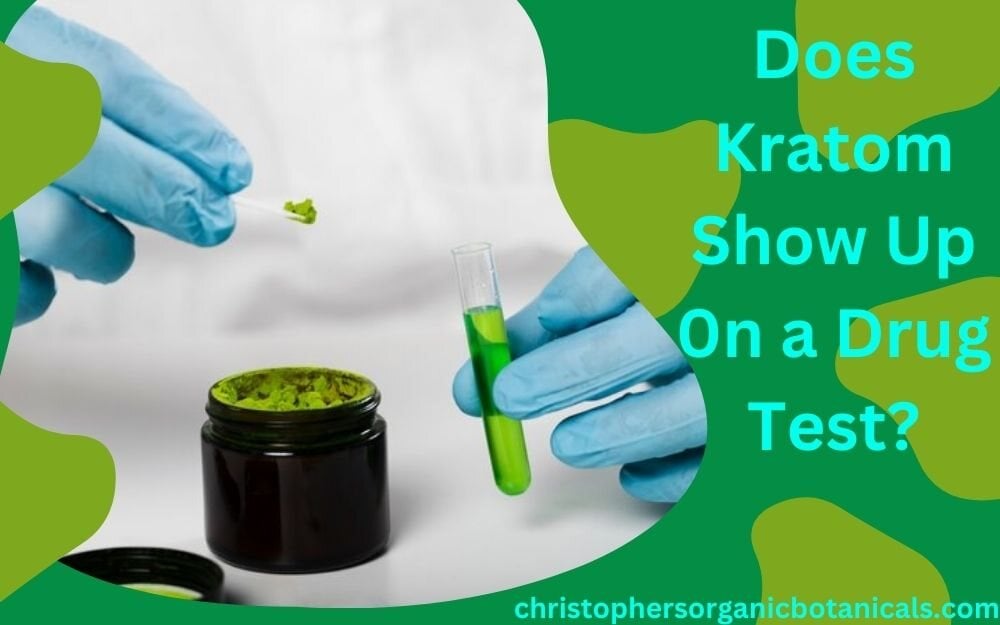Kratom Drug Test
Drug Tests For Kratom are specialized screenings designed to detect the presence of kratom alkaloids (Mitragyna speciosa) in the body. Unlike standard drug tests that screen for commonly abused substances like cannabinoids, opiates, cocaine, amphetamines, and phencyclidine, kratom drug tests specifically look for mitragynine, one of the primary alkaloids found in kratom leaves.
Many people Ask the question? Does Kratom Show up on a drug test? The quick answer is No. Kratom does not show up in standard drug tests.
Here’s what you need to know about kratom drug tests:
Does kratom show up on a 10-panel drug test?
Different organizations or situations may require drug testing protocols to find mitragynine. If you are concerned about mitragyna speciosa showing up in a drug test, it’s best to inquire directly with the testing facility or the party administering the test to determine if mitragyna speciosa will be included in the screening.
Can kratom show up on a drug test? Most likely NO. Kratom doesn’t show up on most standard drug tests, such as the SAMHSA 10-panel, which is commonly used in employment drug screenings and tests for substances like, cocaine, amphetamines, opioids, PCP and other drugs.
Does kratom show up on Drug Tests?
Kratom doesn’t show up on standard drug tests. However, there are more comprehensive drug tests that can detect kratom in the system. People usually do not employ these unless there is a specific reason to test for Mitragynine.
Here are a few points to consider and what you need to know about kratom drug testing.
Does drug court test for kratom?
Specialized tests designed to detect Kratom can identify its primary alkaloids, mitragynine and 7-hydroxymitragynine, in various types of drug testing, including urine, blood, saliva, and hair tests.
However, these tests are not commonly utilized unless there is a specific need to screen for Kratom, such as in areas where its use is regulated or banned. If you are subject to a drug test for drug court or any legal purpose, it is crucial to understand the type of test being administered.
While standard drug tests typically do not detect Kratom, specialized tests will detect kratom. It’s advisable to disclose any Kratom use to the relevant authorities and consult with a healthcare professional if you have concerns about drug testing.
Types of Drug Tests
Standard Drug Tests: Kratom does not show up on most standard drug tests such as the 5-panel drug test that checks for substances like cannabis, cocaine, amphetamines, opioids, and PCP.
Specific Kratom Tests: While standard drug tests typically don’t detect mitragyna speciosa, there are specific tests developed to detect kratom’s primary alkaloids in the urine. However, these tests are not commonly used unless there’s a particular reason to look for the substance.
False Positives: There have been anecdotal reports of kratom leading to false positives on drug tests, especially for opioids. However, these occurrences seem to be rare, and a more detailed subsequent test (like a GC-MS, Gas Chromatography-Mass Spectrometry) should clear up any false positives.
Duration in System: Kratom’s primary alkaloids can be detected in the system for several days after use, depending on various factors like dosage, frequency of use, metabolism, and the type of test used.
Legality and Testing: The legality of kratom varies by country, state, or region. In places where it’s illegal or restricted, there might be a higher chance of testing for kratom.
Employment Drug Tests: Most employers do not specifically test for kratom unless there’s a reason to do so. However, it’s always good to be aware of company policies and local regulations.
Should you harbor worries about mitragynine appearing in a drug test, or if your job necessitates frequent drug screenings, it’s crucial to acquaint yourself with the precise testing procedures and rules pertinent to your job or circumstance. Additionally, think about seeking advice from a medical expert or legal professional if you have particular worries.
If you’re anxious about how kratom use might impact drug testing, it’s strongly advised to consult with a medical expert or the entity administering the drug test. They can offer you precise information and direction tailored to your specific situation.
What does kratom show up as on a drug test?
Kratom (Mitragyna speciosa) contains alkaloids like mitragynine and 7-hydroxymitragynine, which are primarily responsible for its effects. Standard drug tests, such as the SAMHSA-5, do not screen for kratom since it is not a federally regulated substance in many parts of the world, including the United States.
However, specialized kratom tests exist but are not commonly used in routine drug screenings. These tests can detect kratom’s primary alkaloid, mitragynine, and sometimes 7-hydroxymitragynine. Such tests might include specific urine tests, blood tests, or even hair follicle tests designed to identify kratom use.
It’s important to note that because kratom is legal in many areas and not considered an illegal drug, it is typically not included in most drug testing panels unless there is a specific reason to test for it. Organizations that have a particular interest in detecting kratom use, such as those in areas where kratom is banned or regulated, or certain professional settings, might opt for these specialized tests.
In summary, kratom does not show up on standard drug tests. Detection requires specific testing geared towards identifying kratom’s unique alkaloids.
How Long Does Kratom Stay in Your System?
The amount of mitragyna speciosa and its byproducts in the body can vary. This variation depends on factors such as the dosage, frequency of use, individual metabolism, and the sensitivity of drug tests. There is limited research on the exact duration of kratom detection in various drug tests.
However, here is a general guideline for how long kratom may stay in your system:
- Urine Test: In urine tests, kratom can typically be detected for up to 7 days after consumption. However, this detection window may be shorter for infrequent users or those who have consumed lower doses. It is worth noting that kratom’s metabolites can be detected in urine tests, rather than the actual presence of kratom itself.
- Blood Test: In blood tests, kratom’s detection window is relatively shorter, usually ranging from 24 to 48 hours after consumption. This means that speciosa is less likely to be detected in blood tests compared to urine tests.
- Saliva Test: Kratom can be detectable in saliva for up to 1-2 days after use. Doctors do not commonly use saliva tests for detecting kratom, similar to blood tests.
- Hair Test: Hair tests, on the other hand, have a longer detection window for kratom. Mitragynine metabolites can be detected in hair follicles for up to 90 days after consumption. This makes hair tests a more reliable method for detecting speciosa use over an extended period.
Detection times for substances like kratom in drug tests can vary widely due to individual factors such as metabolism and response. While not all standard drug tests screen for kratom, regulations around testing for it can differ by location. To avoid complications with drug tests, consider abstaining from kratom use prior to testing or seek advice from a healthcare professional. It’s also crucial to disclose any substance use to healthcare providers or employers to ensure proper evaluation and care, adhering to the testing rules of your country or workplace.
Kratom half life
The half-life of kratom is the amount of time it takes for the body to reduce its concentration by half. This process happens in the liver, as it breaks down the alkaloids.
Most individuals probably suggest that the half-life of mitragynine is around 24 hours. It can stay in your system for up to nine days, depending on the amount taken and your metabolism rate. It can be detected in urine and blood tests if testing for mitragynine. Tell your doctor if you’re using speciosa, so they can adjust the test results accordingly.
Kratom’s primary active alkaloid, mitragynine, has been the focus of several studies to determine its half-life. Research suggests that the half-life of mitragynine lasts approximately 23.24 ± 16.07 hours, or roughly around 24 hours. However, this can vary based on several factors, including the user’s metabolic rate, age, genetic makeup, liver function, and the method of consumption.
People generally believe that the body completely removes a drug after about 5-6 half-lives. This is a general figure though; the actual elimination rate of a drug will depend on various factors in each individual. Thus, given this information, it would take about 5–6 days to totally eliminate kratom from the system.
These findings imply that kratom and its effects can last in the body for a significant duration, potentially longer than a day. This extended half-life suggests that kratom could accumulate in the system with repeated use, affecting tolerance, dependence, and the potential for side effects.
Given the variability in kratom’s metabolism among individuals and the limited research, users should approach dosage and frequency with caution, particularly those new to kratom or those using it for chronic conditions. As research continues, more detailed information on kratom’s pharmacokinetics will likely emerge, offering clearer guidelines for its safe use.
Conclusion
Kratom, a tropical tree from Southeast Asia, has been noted for its potential medicinal benefits. However, its alkaloids might interfere with drug tests, possibly causing false positives.
Consulting a doctor is vital as they understand your health background and medications, and can advise on kratom’s suitability for you, especially in relation to drug testing.
It’s also important to communicate with the entity conducting the drug test, such as employers or probation officers, to adhere to their policies on kratom use.
Legal and responsible use of kratom is emphasized, with a recommendation to familiarize oneself with local laws and regulations regarding its consumption. To avoid complications related to drug testing and kratom use, seeking advice from healthcare providers or the testing organization is suggested for personalized guidance and to ensure legal compliance and safety.






0 Comments